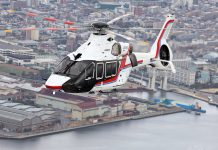 The first electric aircraft to carry the Air New Zealand name hit the skies Friday (17 October) with the BETA ALIA CX300 taking off from Tauranga Airport in its first test flight in New Zealand. The aircraft was manufactured in the United States by global aviation innovator BETA Technologies. It arrived in the country last week and was blessed at a sunrise ceremony in Tauranga. The aircraft will be based at Hamilton Airport before moving to Wellington Airport for a further two months in December.
The first electric aircraft to carry the Air New Zealand name hit the skies Friday (17 October) with the BETA ALIA CX300 taking off from Tauranga Airport in its first test flight in New Zealand. The aircraft was manufactured in the United States by global aviation innovator BETA Technologies. It arrived in the country last week and was blessed at a sunrise ceremony in Tauranga. The aircraft will be based at Hamilton Airport before moving to Wellington Airport for a further two months in December.
Baden Smith, Air New Zealand’s General Manager – Fleet, Networks and Strategy, says the first flight marks an important milestone in the airline’s Next Generation Aircraft programme, and the innovation journey the airline is on to understand how different technology might work in New Zealand and globally in the future. “New Zealand has a proud history of aviation innovation and pushing for progress, whether it’s Richard Pearse who first opened the skies with flying machines, to the era of TEAL flying boats, through to engineers and aviators who connected us to the world. It’s incredibly special to partner with a global innovator like BETA to ensure New Zealand is a part of shaping what the future of flight might look like both here and around the world. We know aviation will keep changing – it always has. This is a small, cautious step to learn and be part of that change.”
BETA Technologies Director of Flight Operations, Chris Caputo, says, “This first flight marks the powerful intersection of pragmatic design and operational innovation. We built the ALIA CX300 on a foundation of simplicity to ensure a fast, safe, and efficient path to commercial service. With this ‘Tech Demonstrator’ collaboration, Air New Zealand is not just validating a single aircraft – they are creating the rigorous operational blueprint that will serve as a model for operators around the world who are serious about unlocking low-cost, sustainable connectivity for their regional communities.”
The ALIA CX300 has been leased by Air New Zealand for four months for a technical demonstrator programme, which enables the airline, alongside partners and regulators, to learn how the aircraft will perform in New Zealand conditions, and to start pilot and engineering familiarisation. It’s also an opportunity for New Zealanders to see battery-electric aviation technology up close. During the aircraft’s time in Hamilton, Air New Zealand and BETA teams will undertake a programme of flights in a range of conditions and altitudes. In December it will move to Wellington, where it will complete flights between Wellington and Blenheim.
EHang launches AAM sandbox initiative in Thailand
 EHang announced that the launch of an AAM Sandbox Initiative in Thailand in collaboration with the Civil Aviation Authority of Thailand (“CAAT”) and local partners. The initiative aims to fast-track the future commercial operations of EHang’s EH216-S pilotless eVTOL aircraft in the country, with the goal of establishing the world’s first commercial eVTOL operations using an innovative regulatory approach of “sandbox”. Today, continuous trial operations with EH216-S have successfully commenced at the first sandbox area in Bangkok, with plans to expand to more sandbox areas across Thailand.
EHang announced that the launch of an AAM Sandbox Initiative in Thailand in collaboration with the Civil Aviation Authority of Thailand (“CAAT”) and local partners. The initiative aims to fast-track the future commercial operations of EHang’s EH216-S pilotless eVTOL aircraft in the country, with the goal of establishing the world’s first commercial eVTOL operations using an innovative regulatory approach of “sandbox”. Today, continuous trial operations with EH216-S have successfully commenced at the first sandbox area in Bangkok, with plans to expand to more sandbox areas across Thailand.
During the event, the EH216-S completed a series of point-A-to-point-B autonomous flights with consistent stability, demonstrating its integrated flight control systems and operational reliability. The event gathered senior officials from the CAAT and the Ministry of Transport (“MOT”) of Thailand, along with key industry partners including Aerial Sea Ventures, Energy Absolute, Amita Technology, G Capital, China Harbour Engineering Company, Bangkok Airways, VietJet, and Tahira Group from Malaysia.
EHang also held a technical meeting with CAAT officials, presenting the EH216-S’s comprehensive safety architecture, Unmanned Aircraft System Traffic Management (“UTM”) integration, risk assessment framework, and flight-testing methodology. This multi-party collaboration with the Initiative represents a significant step toward gaining local regulatory approval for future commercial operations in sandbox areas across Thailand.
Under the Initiative, EHang’s local partners will provide essential operational support, ranging from infrastructure to operational teams. They plan to expand the sandbox areas to Pattaya, Koh Larn, Phuket, Koh Samui and many other locations in Thailand for more sightseeing flight routes and transportation services.



















